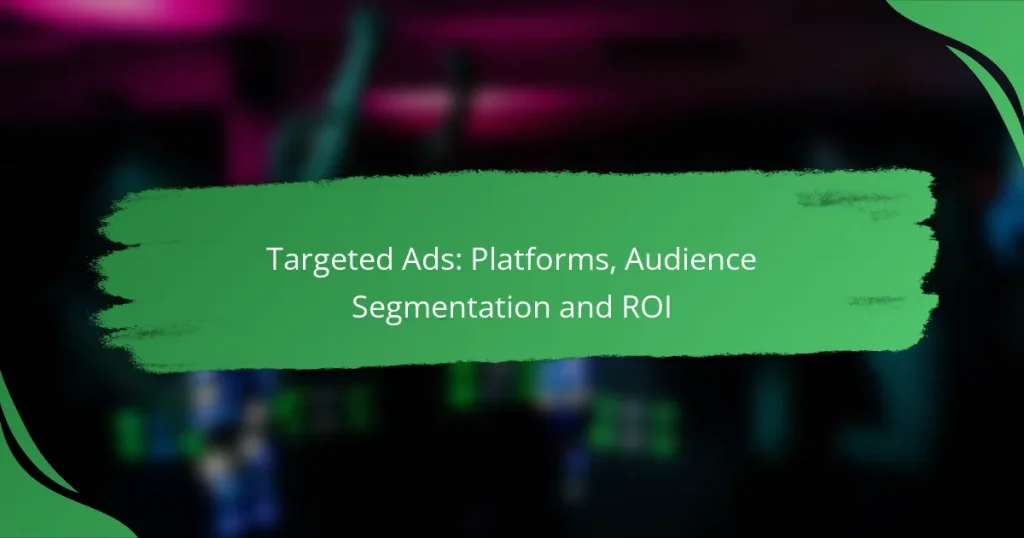Targeted advertising has become a cornerstone of successful e-commerce strategies, leveraging platforms like Google Ads, Facebook Ads, and Amazon Advertising to reach specific audiences effectively. By segmenting audiences into smaller, defined groups based on characteristics, businesses can enhance ad relevance and improve their return on investment (ROI). Understanding and optimizing ROI is essential for evaluating the effectiveness of these advertising efforts and maximizing marketing budgets.

What are the best platforms for targeted ads in e-commerce?
The best platforms for targeted ads in e-commerce include Google Ads, Facebook Ads, Amazon Advertising, LinkedIn Ads, and Twitter Ads. Each platform offers unique features and audience targeting options that can significantly enhance your advertising effectiveness and return on investment (ROI).
Google Ads
Google Ads allows businesses to target potential customers through search results and display networks. Advertisers can use keywords to reach users actively searching for related products, making it a powerful tool for capturing intent-driven traffic.
Consider using Google Ads’ various formats, such as text ads, shopping ads, and video ads, to engage different audience segments. A well-structured campaign can yield a return on ad spend (ROAS) of several times the initial investment.
Facebook Ads
Facebook Ads provides robust audience segmentation capabilities based on demographics, interests, and behaviors. This platform is particularly effective for visually appealing products, allowing businesses to create engaging ads that resonate with specific user groups.
Utilize Facebook’s retargeting options to reach users who have previously interacted with your brand. Testing different ad formats, such as carousel ads or video ads, can help optimize performance and improve conversion rates.
Amazon Advertising
Amazon Advertising is ideal for e-commerce businesses selling products directly on Amazon. It offers various ad types, including Sponsored Products and Sponsored Brands, which help increase visibility and drive sales within the Amazon ecosystem.
Focus on optimizing your product listings and using relevant keywords to enhance your ad performance. Given Amazon’s vast customer base, effective campaigns can lead to significant sales growth and brand recognition.
LinkedIn Ads
LinkedIn Ads is best suited for B2B e-commerce businesses targeting professionals and decision-makers. The platform allows for precise targeting based on job title, industry, and company size, making it effective for niche markets.
Consider using Sponsored Content and InMail ads to engage your audience directly. While LinkedIn Ads may have a higher cost per click compared to other platforms, the quality of leads can justify the investment.
Twitter Ads
Twitter Ads enables businesses to reach users through promoted tweets and trends, making it suitable for real-time engagement. This platform is effective for brands looking to capitalize on trending topics or events.
Utilize Twitter’s targeting options, such as interests and keywords, to connect with relevant audiences. Keep your messaging concise and engaging, as Twitter’s character limit requires impactful communication to capture attention quickly.

How to segment audiences for targeted ads?
Segmenting audiences for targeted ads involves dividing a broad audience into smaller, more defined groups based on specific characteristics. This approach enhances ad relevance and improves return on investment (ROI) by ensuring that marketing messages resonate with the right people.
Demographic segmentation
Demographic segmentation categorizes audiences based on quantifiable characteristics such as age, gender, income, education, and marital status. For example, a luxury car brand may target high-income individuals aged 30-50, while a children’s toy company focuses on parents aged 25-40.
When implementing demographic segmentation, consider using surveys or customer data analysis to gather relevant information. This method helps in crafting tailored messages that appeal directly to the needs and preferences of each demographic group.
Behavioral segmentation
Behavioral segmentation divides audiences based on their interactions with a brand, including purchase history, product usage, and engagement levels. For instance, frequent buyers may receive loyalty rewards, while occasional shoppers might get special offers to encourage more purchases.
To effectively use behavioral segmentation, track user actions through analytics tools. This data can inform targeted campaigns that address specific behaviors, such as cart abandonment or product browsing, ultimately enhancing conversion rates.
Geographic segmentation
Geographic segmentation focuses on the location of the audience, allowing marketers to tailor ads based on regional preferences, climate, or cultural factors. For example, a clothing retailer might promote winter apparel in colder regions while highlighting summer attire in warmer areas.
Utilizing geographic segmentation requires understanding local trends and consumer behavior. Consider using location-based advertising tools to deliver relevant messages to users based on their physical location, which can significantly improve engagement and sales.
Psychographic segmentation
Psychographic segmentation categorizes audiences based on their lifestyles, values, interests, and personalities. This approach goes beyond demographics to understand what motivates consumers, such as a brand’s commitment to sustainability attracting eco-conscious buyers.
To implement psychographic segmentation, conduct market research through surveys or focus groups to uncover consumer attitudes and preferences. This insight allows for the creation of compelling narratives that resonate deeply with targeted audiences, fostering brand loyalty.

What is the ROI of targeted ads?
The ROI of targeted ads refers to the return on investment generated from advertising efforts aimed at specific audiences. It is a critical metric that helps businesses evaluate the effectiveness of their advertising strategies and optimize their marketing budgets.
Measuring ROI with analytics tools
To measure the ROI of targeted ads, businesses can utilize various analytics tools that track performance metrics. Key metrics include conversion rates, customer acquisition costs, and revenue generated from ads. Tools like Google Analytics and Facebook Ads Manager provide insights into how well ads are performing against set objectives.
Setting up proper tracking mechanisms, such as UTM parameters, can help attribute conversions directly to specific ad campaigns. This allows for a clearer understanding of which ads yield the highest returns.
Average ROI benchmarks for e-commerce
In the e-commerce sector, average ROI for targeted ads can vary widely but often falls within the range of 200% to 400%. This means that for every dollar spent on advertising, businesses can expect to earn two to four dollars in return. However, these figures can fluctuate based on factors like industry, ad quality, and audience targeting precision.
For instance, businesses in highly competitive markets may experience lower ROI, while niche markets might see higher returns due to less competition. Regularly reviewing and adjusting ad strategies can help maintain or improve these benchmarks.
Factors affecting ROI
Several factors can significantly impact the ROI of targeted ads. Audience segmentation plays a crucial role; well-defined target groups typically yield better results than broad audiences. Additionally, ad quality, including visuals and messaging, can influence engagement and conversion rates.
Budget allocation is another important consideration. Over-investing in low-performing ads can diminish overall ROI, while reallocating funds to high-performing campaigns can enhance returns. Regular analysis and optimization of ad performance are essential for maximizing ROI.

What are the prerequisites for effective targeted ads?
Effective targeted ads require a deep understanding of your audience and clear objectives. By defining customer personas and setting specific advertising goals, you can enhance your ad performance and return on investment (ROI).
Understanding customer personas
Customer personas are semi-fictional representations of your ideal customers based on data and research. To create accurate personas, gather insights from customer demographics, behaviors, and preferences. This helps in tailoring your messaging and targeting strategies.
Consider factors such as age, gender, location, interests, and purchasing habits. For instance, a persona for a luxury skincare brand might focus on affluent women aged 30-50 who value high-quality ingredients and sustainability.
Setting clear advertising goals
Setting clear advertising goals is essential for measuring success and guiding your campaigns. Goals should be specific, measurable, achievable, relevant, and time-bound (SMART). For example, aim to increase website traffic by 20% over three months or generate 100 new leads per month.
Align your goals with your overall business objectives. If your aim is to boost sales, focus on conversion rates and return on ad spend (ROAS). Regularly review and adjust your goals based on campaign performance to ensure continuous improvement.

How to optimize targeted ads for better performance?
To optimize targeted ads for better performance, focus on refining your audience segmentation, selecting the right platforms, and continuously analyzing your return on investment (ROI). Effective optimization involves understanding your target audience’s behavior and preferences, which can significantly enhance ad effectiveness.
Platforms for targeted ads
Choosing the right platforms for targeted ads is crucial for reaching your desired audience. Popular options include social media networks like Facebook, Instagram, and LinkedIn, as well as search engines like Google. Each platform offers unique targeting capabilities, allowing you to tailor your ads based on demographics, interests, and online behavior.
Consider where your audience spends their time online. For instance, if you are targeting professionals, LinkedIn may be more effective than Instagram. Additionally, evaluate the cost structures of each platform, as they can vary significantly, impacting your overall budget.
Audience segmentation strategies
Effective audience segmentation strategies enhance the relevance of your targeted ads. Start by defining key characteristics such as age, location, interests, and purchasing behavior. Use data analytics tools to gather insights about your audience, which can help in creating tailored ad campaigns.
Consider segmenting your audience into smaller groups for more personalized messaging. For example, a clothing retailer might target young adults with trendy styles while promoting classic designs to older consumers. This approach can lead to higher engagement rates and improved conversion outcomes.
Measuring ROI from targeted ads
Measuring ROI from targeted ads is essential to determine their effectiveness. Calculate ROI by comparing the revenue generated from ads against the total costs incurred. A common formula is (Revenue – Cost) / Cost, which gives you a percentage that indicates profitability.
Track key performance indicators (KPIs) such as click-through rates, conversion rates, and customer acquisition costs. Regularly reviewing these metrics allows you to adjust your strategies and improve ad performance over time. Aim for a positive ROI, typically in the range of 300-500%, to ensure your advertising efforts are worthwhile.


